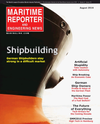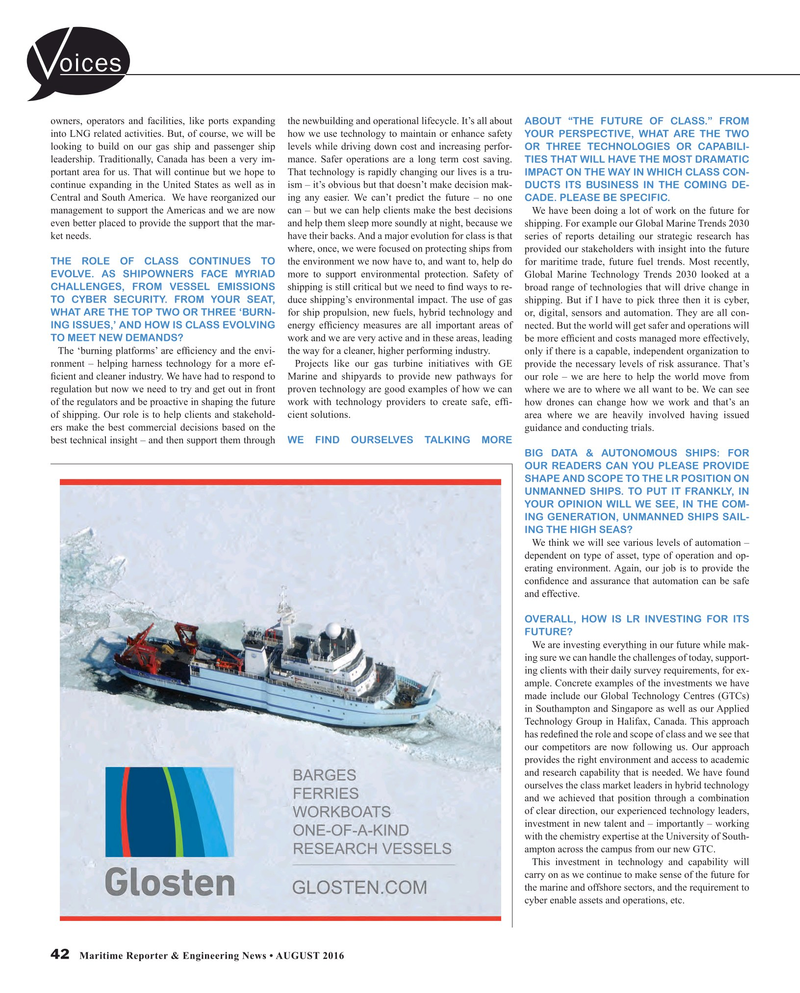
Page 42: of Maritime Reporter Magazine (August 2016)
The Shipyard Edition
Read this page in Pdf, Flash or Html5 edition of August 2016 Maritime Reporter Magazine
oices owners, operators and facilities, like ports expanding the newbuilding and operational lifecycle. It’s all about ABOUT “THE FUTURE OF CLASS.” FROM into LNG related activities. But, of course, we will be how we use technology to maintain or enhance safety YOUR PERSPECTIVE, WHAT ARE THE TWO looking to build on our gas ship and passenger ship levels while driving down cost and increasing perfor- OR THREE TECHNOLOGIES OR CAPABILI- leadership. Traditionally, Canada has been a very im- mance. Safer operations are a long term cost saving. TIES THAT WILL HAVE THE MOST DRAMATIC portant area for us. That will continue but we hope to That technology is rapidly changing our lives is a tru- IMPACT ON THE WAY IN WHICH CLASS CON- continue expanding in the United States as well as in ism – it’s obvious but that doesn’t make decision mak- DUCTS ITS BUSINESS IN THE COMING DE-
Central and South America. We have reorganized our ing any easier. We can’t predict the future – no one CADE. PLEASE BE SPECIFIC.
management to support the Americas and we are now can – but we can help clients make the best decisions We have been doing a lot of work on the future for even better placed to provide the support that the mar- and help them sleep more soundly at night, because we shipping. For example our Global Marine Trends 2030 ket needs. have their backs. And a major evolution for class is that series of reports detailing our strategic research has where, once, we were focused on protecting ships from provided our stakeholders with insight into the future
THE ROLE OF CLASS CONTINUES TO the environment we now have to, and want to, help do for maritime trade, future fuel trends. Most recently,
EVOLVE. AS SHIPOWNERS FACE MYRIAD more to support environmental protection. Safety of Global Marine Technology Trends 2030 looked at a
CHALLENGES, FROM VESSEL EMISSIONS shipping is still critical but we need to ? nd ways to re- broad range of technologies that will drive change in
TO CYBER SECURITY. FROM YOUR SEAT, duce shipping’s environmental impact. The use of gas shipping. But if I have to pick three then it is cyber,
WHAT ARE THE TOP TWO OR THREE ‘BURN- for ship propulsion, new fuels, hybrid technology and or, digital, sensors and automation. They are all con-
ING ISSUES,’ AND HOW IS CLASS EVOLVING energy ef? ciency measures are all important areas of nected. But the world will get safer and operations will
TO MEET NEW DEMANDS? work and we are very active and in these areas, leading be more ef? cient and costs managed more effectively,
The ‘burning platforms’ are ef? ciency and the envi- the way for a cleaner, higher performing industry. only if there is a capable, independent organization to ronment – helping harness technology for a more ef- Projects like our gas turbine initiatives with GE provide the necessary levels of risk assurance. That’s ? cient and cleaner industry. We have had to respond to Marine and shipyards to provide new pathways for our role – we are here to help the world move from regulation but now we need to try and get out in front proven technology are good examples of how we can where we are to where we all want to be. We can see of the regulators and be proactive in shaping the future work with technology providers to create safe, ef? - how drones can change how we work and that’s an of shipping. Our role is to help clients and stakehold- cient solutions. area where we are heavily involved having issued ers make the best commercial decisions based on the guidance and conducting trials.
best technical insight – and then support them through WE FIND OURSELVES TALKING MORE
BIG DATA & AUTONOMOUS SHIPS: FOR
OUR READERS CAN YOU PLEASE PROVIDE
SHAPE AND SCOPE TO THE LR POSITION ON
UNMANNED SHIPS. TO PUT IT FRANKLY, IN
YOUR OPINION WILL WE SEE, IN THE COM-
ING GENERATION, UNMANNED SHIPS SAIL-
ING THE HIGH SEAS?
We think we will see various levels of automation – dependent on type of asset, type of operation and op- erating environment. Again, our job is to provide the con? dence and assurance that automation can be safe and effective.
OVERALL, HOW IS LR INVESTING FOR ITS
FUTURE?
We are investing everything in our future while mak- ing sure we can handle the challenges of today, support- ing clients with their daily survey requirements, for ex- ample. Concrete examples of the investments we have made include our Global Technology Centres (GTCs) in Southampton and Singapore as well as our Applied
Technology Group in Halifax, Canada. This approach has rede? ned the role and scope of class and we see that our competitors are now following us. Our approach provides the right environment and access to academic and research capability that is needed. We have found ourselves the class market leaders in hybrid technology and we achieved that position through a combination of clear direction, our experienced technology leaders, investment in new talent and – importantly – working with the chemistry expertise at the University of South- ampton across the campus from our new GTC.
This investment in technology and capability will carry on as we continue to make sense of the future for the marine and offshore sectors, and the requirement to cyber enable assets and operations, etc.
42 Maritime Reporter & Engineering News • AUGUST 2016
MR #8 (42-49).indd 42 8/3/2016 10:36:08 AM

 41
41

 43
43
